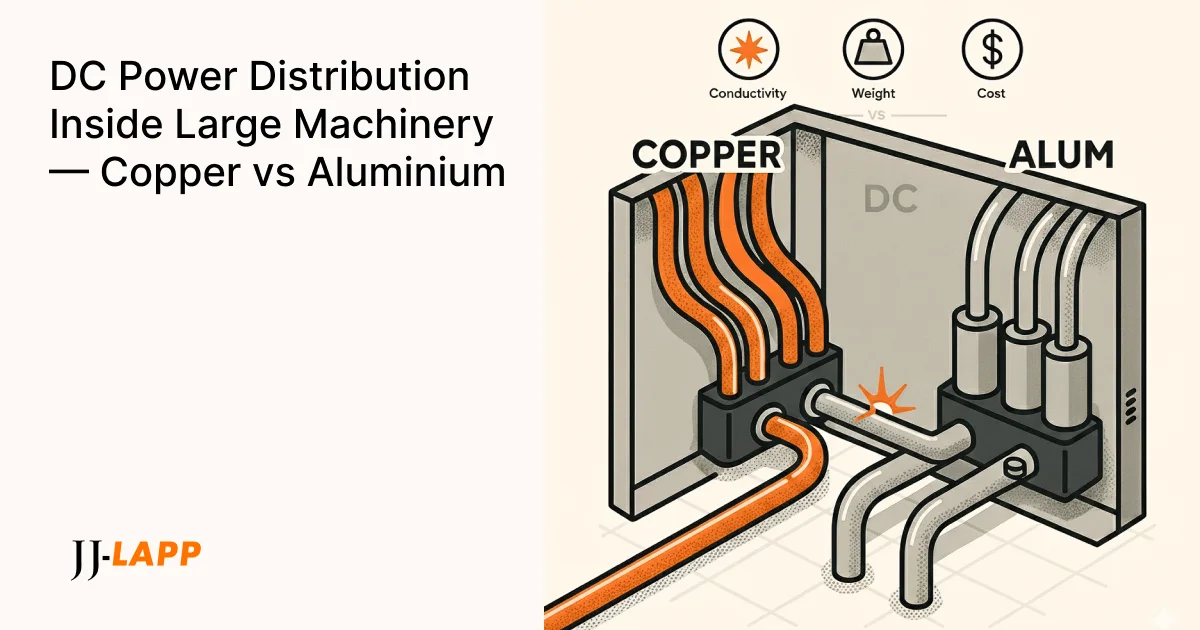Your new machine passes factory testing with flying colours. But three months after installation at a customer’s site in a humid coastal city like Da Nang, a critical drive fails. The cause: a corroded, loose aluminium cable termination that couldn’t handle the machine’s vibration and the local humidity. The attempt to save a few hundred dollars on cable has now cost thousands in repairs and damaged your reputation.
As machinery electrifies and DC power distribution becomes more common, the choice of conductor material has a major impact on performance, safety, and long‑term cost. While aluminium appears cheaper upfront, this guide shows why, for the high‑precision, vibration‑prone environment inside large machinery, the properties of copper help maximise uptime.
Context from LAPP’s DC programme: LAPP contributes to industrial DC research (e.g., DC‑INDUSTRIE2/ODCA) and publishes guidance on DC grids, safety and component selection. In short: dimension per recognised standards, verify voltage drop, and use DC‑rated components throughout the system (no live disconnections due to DC arcing).
Why the Conductor Debate Matters for Modern Machinery
Direct Current (DC) is no longer just for small electronics. The rise of battery‑powered AGVs, high‑performance servo drive systems, and on‑site renewable integration means efficient DC power distribution is now part of modern machine design.
This shift raises a key question for machine builders in Southeast Asia: which conductor offers the best balance of performance, reliability and cost—copper or aluminium? Aluminium shines where weight and span dominate (e.g., overhead lines). Inside a compact, high‑vibration machine, the engineering calculus changes.
Copper vs Aluminium: A Practical Comparison for OEMs
| Factor | Copper | Aluminium | The Impact Inside a Machine |
| Conductivity | Higher conductivity for a given cross‑section | Lower conductivity for a given cross‑section | Lower cable voltage drop and heat for the same current → steadier DC bus for drives and controls. |
| Size | More compact for a target ampacity | Requires a larger cross‑section for the same ampacity | Saves space in crowded cabinets, ducts and trays. |
| Weight | Heavier | Lighter | Weight is seldom the limiting factor inside a cabinet; routing space usually is. |
| Termination | Straightforward with widely available lugs and processes | Requires special lugs, preparation and process control | Reduces risk of connection issues from vibration and surface films; easier quality control during assembly. |
| Durability | Ductile with good tensile strength | Lower strength and less forgiving to repeated flex/vibration | Better resilience to machine vibration and maintenance handling. |
| Cost | Higher purchase price | Lower purchase price | Lower initial cost vs. higher lifetime risk; consider Total Cost of Ownership (TCO). |
A DC Design Checklist (map it before you buy)
- Dimension the conductor according to recognised tables (e.g., installation method, ambient, grouping), then verify voltage drop for the actual run length and operating temperature.
- Use DC‑rated components across the system (switching, protection, connectors); avoid live plugging/unplugging—DC arcs do not self‑extinguish.
- Document the DC layout (e.g., AC‑earthed/TN‑S/IT) and keep polarity and colour coding consistent in harnesses and terminations.
Why Copper is the Safer Bet Inside a Machine
Conductivity and Stable DC Voltage
Higher conductivity helps minimise losses and heat for a given cross‑section. That means cooler cabinets and a steadier DC bus for servo drives and controllers—both support better OEE.
Rule of thumb: calculate expected voltage drop for the actual length and temperature after you size the cable from the installation table; adjust cross‑section until the drop is within your design limit.
Space Constraints in Modern Designs
Inside dense machine cabinets, tray and gland space is precious. Because aluminium generally needs a larger cross‑section for the same current, it can force upsizing of ducts, trays and glands—eroding any material savings.
The Critical Risk of Termination Failure
This is the single biggest reliability argument for copper. Aluminium forms a hard surface film and has higher thermal expansion—both demand special lugs, surface preparation and controlled installation to achieve low, stable contact resistance. In a vibrating machine, even a small loss of contact pressure can become a hot spot. Copper’s termination window is wider and easier to keep stable over time when proper crimping practices are followed.
Durability Against Vibration and Handling
Cables inside machines see vibration and occasional re‑termination during service. Copper’s ductility and strength provide a margin against fatigue and handling damage that aluminium does not easily forgive.
Map the Application to the Right ÖLFLEX® DC Family
LAPP’s DC portfolio spans fixed, chain and torsion duties so you can keep one system supplier while matching the motion profile:
- ÖLFLEX® DC GRID 100 – distribution inside cabinets and machines (fixed routing).
- ÖLFLEX® DC ESS SC – battery/energy‑storage links and DC busbars.
- ÖLFLEX® DC CHAIN 800 – continuous bending in cable chains (dynamic).
- ÖLFLEX® DC ROBOT 900 – multi‑axis torsion paths in robot dress packs.
- ÖLFLEX® DC SERVO 700 – DC links around servo drives.
(Always confirm part‑number‑specific ratings—cross‑section, temperature, bend radius, and approvals—on the current product sheet.)
The Bottom Line: Don’t Compromise Inside the Machine
Aluminium has a role in large‑scale power transmission. Inside machinery, the combination of space constraints, vibration and termination reliability makes copper the more robust engineering choice for DC power distribution.
Ready to compare options? Browse ÖLFLEX® DC cables on the JJ‑LAPP eShop, or talk to us to review your application. Learn more about the LAPP brand and its DC portfolio on our LAPP brand page.
Local stock. German quality. Reliably Connecting ASEAN.
